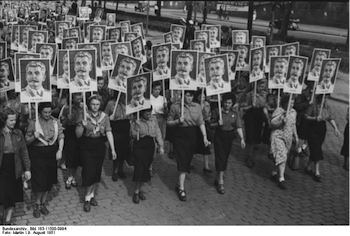

|
Containment  Girls' Parade, Berlin, 1951 That new policy of 'containment' had its origins in the 'Long Telegram' sent by George Kennan, the deputy head of the US Mission in Moscow, to James Byrnes, the Secretary of State. Kennan was frustrated by the US policy of cooperation with the Soviet Union, which he believed was incapable of peaceful co-existence with capitalism. Politically insecure and terrified of capitalist encirclement', the Soviet regime would, in his view, defend itself by attacking its capitalist enemies: in Soviet thinking, 'offense and defense [were] inextricably confused'. To contain the Soviet threat Kennan argued that US policy should aim to strengthen democratic institutions in the West and exert counter-pressure against the USSR 'at a series of constantly shifting geographical and political points.' The key to this strategy would be the combination of US atomic power and the British Empire's military bases around the globe. Recalled to Washington, Kennan helped to shape the Truman Doctrine of providing aid to countries to prevent them falling to the Communists. The Marshall Plan was part of this containment policy. Named after George Marshall, the Secretary of State, the plan aimed to rebuild the war-devastated economies of Europe by huge grants, credits and free trade, linked to the building of democracy. At the Paris conference to discuss the plan in June 1947, Marshall offered aid to the Soviet Union and its allies. Although Stalin welcomed the possibility of US credits to rebuild the Soviet economy, he rightly suspected that the real aim of the Plan was to drive a wedge between the USSR and the countries in its sphere of influence. Stalin would have nothing to do with it and imposed the Moscow line on Eastern Europe's Communist leaders. |
© 2014 Orlando Figes | All Rights Reserved